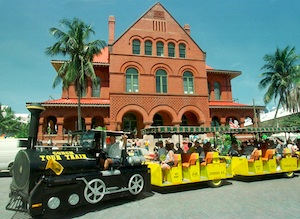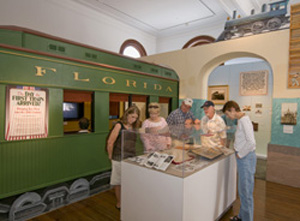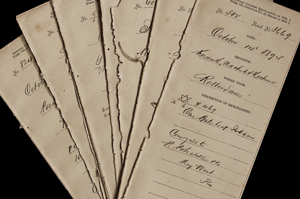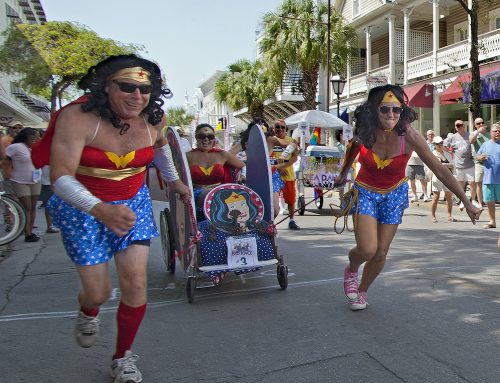With 12 fireplaces and a roof steeply angled so snow can’t accumulate on it, the Custom House isn’t exactly a typical building in frost-free Key West. But it’s definitely one of the most architecturally significant — and this year it celebrates its 125th birthday.

A Conch Tour Train rolls by the restored Custom House, one of Florida’s most unique architectural structures, shortly after its debut as a museum. (Photo by Andy Newman, Florida Keys News Bureau)
Actually the red-brick Custom House, which towers imposingly beside Key West Harbor, is one of the most unique architectural structures in Florida. Its 20-foot ceilings, dramatic arched windows and grand staircase would look right at home in a mega-millionaire’s mansion.
It’s also one of the best-preserved examples of Richardsonian Romanesque architecture (i.e., based on the work of famed designer Henry Hobson Richardson) in the entire United States. Completed in 1891, it followed a standard federal building pattern — a pattern that probably explains the fireplaces and snow-resistant roofline so incongruous in subtropical Key West.
Today a museum that showcases the Florida Keys’ art and heritage, the Custom House has a history as unique as its design.
After its debut 125 years ago — when Key West was the largest city in Florida — the building was home to the collector of customs (naturally), federal court, post office and lighthouse services. In 1898 it housed a court of inquiry into the battleship Maine’s sinking in Havana Harbor. In later years, trials for infamous Keys rumrunners were held in the building. Eventually a center for civil service and Naval activity, it was abandoned in 1974.

Custom House visitors examine an exhibit commemorating the 100th anniversary of the birth of Henry Flagler’s Florida Keys Over-Sea Railroad. (Photo by Andy Newman, Florida Keys News Bureau)
In 1991 the Key West Art & Historical Society took it over and began historic preservation and restoration, which evolved into a nine-year endeavor. The restored building was reborn as the Key West Museum of Art & History, and its grand opening featured a colorful parade of “mobile folk art” — more than 50 colorful painted vehicles that came from as far away as California.
These days it’s simply called the Custom House Museum. And just as it was 125 years ago, it’s a focal point for the Key West community.
Since its rebirth, the museum has hosted exhibits on subjects that made news around the island and the globe. Like the U.S.S. Maine’s 1898 voyage from Key West to Havana, where its explosion helped ignite the Spanish-American War. The little-known paintings of playwright and longtime Key West resident Tennessee Williams, and the stunning sketches and painted woodcarvings of the island’s world-renowned folk artist Mario Sanchez.
A permanent exhibit titled “Flagler’s Speedway to Sunshine” explores the Florida Keys Over-Sea Railroad, conceived by Standard Oil tycoon Henry Flagler and completed in 1912. The amazing railroad ran from mainland Florida to Key West, over vast stretches of open water, connecting the once-isolated Keys with each other and the “real world” for the first time. Exhibit elements include a re-created railcar, scores of railway artifacts and even vintage footage of the journey from the Middle Keys to Key West.

Customs forms like this 1894 example will be displayed in the “Custom Made” exhibition. (Photo courtesy the Key West Art & Historical Society.
Equally fascinating is the Custom House’s incomparable collection of artifacts, belongings and documents related to Ernest Hemingway — who spent most of the 1930s living and writing in Key West. Highlights include Hemingway’s fishing logs, handwritten descriptions of his local angling adventures, bullfighting memorabilia, family items and the manuscript of his novel “Death in the Afternoon.”
In fact, the museum presents ever-evolving exhibits on aspects of Hemingway’s Key West life, work and on-the-water exploits. In 2015, Ernest’s grandson John Hemingway helped launch “Following the Fish,” pairing his grandfather’s love of Keys fishing and lesser-known activities in marine conservation.
The Custom House itself is the subject of the latest exhibit within its walls. “Custom Made” salutes the architectural gem’s 125-year history, displaying treasures that include sections of the building’s original woodwork, 19th-century customs forms, views of the original floorplans and materials used in the restoration.
“Custom Made” runs from Aug. 26 through Dec. 6. And while it spotlights the importance of historic preservation and historic places, it also offers a memorable glimpse into Key West’s unparalleled history. Don’t miss it!





